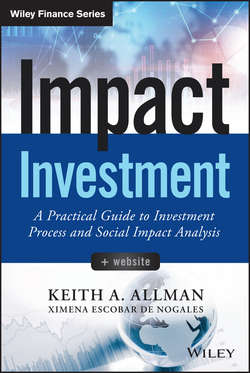Читать книгу Impact Investment - Allman Keith А. - Страница 6
На сайте Литреса книга снята с продажи.
Chapter 1
Introduction to Impact Investing
ОглавлениеIt is an extremely tempting proposition: Invest money in a business whose product or service offers financial return and at the same time generates positive social impact. All parties seem to win, with an investor making a return and society benefiting. A charity could direct money into an organization that accomplishes the same social mission as one it grants to, but instead is able to receive back and reinvest the granted funds. What could hinder such a paradigm?
This idealistic form of capitalism has surged in the last few years. As of 2014, over USD12.7 billion has been committed to impact investing, representing a growth of 19 percent from the prior year.1 Numerous investors are active ranging from lone high net worth individuals to a multitude of private equity funds. Even larger-scale financial institutions and investment firms have dedicated funds and resources to impact investing. Ancillary services have emerged to support these investors and further develop the industry including secondary market platforms, capital advisers who specialize in impact investments, and services to validate and rate social performance.
With such fervor, why does it still seem like the impact investing market is constrained? The simple answer is that it is not easy to both create a profitable business that has a significant social impact and also scale that business so that it generates commercial returns for investors and continues to progress its social mission. It comes as no shock, then, that for a number of years in a row, J.P. Morgan's impact investing survey cites “a shortage of high quality investment opportunities with track records” and a “lack of appropriate capital across the risk/return spectrum” as primary hindrances to the growth of impact investing.2
Part of the issue is that impact investing appeals to our senses and consciences through innovative solutions to pressing social problems. This thought should not be misinterpreted though, as many of the entities and businesses an investor encounters when reviewing social enterprises legitimately intend to or are actively creating significant positive social value. The problem is that a majority of these businesses are not commercially viable and will not generate the return that many investors require. Our morality wants to support these investments, so the industry has grown considerably to encourage social enterprises, but as investors, we must maintain a fiduciary responsibility and invest at the appropriate risk-return level.
However, as we seek to increase the scope of suitable investments, we run the risk of going over an inflexion point, where social impact has been compromised so much that the investment can no longer be considered an impact investment. This can either occur by investing in businesses that actually do not have significant social impact or by investing in a social enterprise that alters itself to become a traditional company. At that point, we have become traditional investors and the paradigm is lost.
We now find ourselves in a delicate situation, balancing financial viability, monetary return expectations, and social impact. How do we achieve the correct balance? As with most industries, the solution is basically hard work and being equipped with the right resources and knowledge. We must know how to look for the right investments and how to screen out ones that are not financially sustainable or demonstrating the right level of social impact. Once found, we must adhere to a rigorous investment process and vet a company to establish its financial and social value. The investment structures created need to properly balance risk and reward. Documentation needs to be done professionally to accurately reflect the structure created and the intentions of all parties. We have to endure far beyond the investment phase, helping businesses scale and exit positions with financial and social success.
It is easy to discuss the beneficial attributes of impact investing and package it in a way that sells a good story. The hard work is in proper investment execution. To get there, this book addresses the following:
● Knowing how to source deals domestically and internationally, while mitigating foreign exchange and business cycle risk
● Properly mapping out the social impact of a company and the metrics that prove it
● Being able to understand, build, and utilize multi-method valuations
● Drafting a term sheet that takes into consideration commercial and social mission risk
● Monitoring and managing an investment to ensure financial and social returns
● Understanding the economics and realities of leveraging other people's money in impact investment funds
Although a shortage of quality investments vis-à-vis investors exists and will most likely be commonplace with the high degree of interest in impact investing, excellent investments can be found that marry profitability and social impact. This book and the online resources that accompany it will assist investors in choosing the right investments, help align risk and reward, and contribute toward investors building financial and social value.
1
Yasemin Saltuk. J.P. Morgan, “Spotlight on the Market: The Impact Investor Survey,” Global Social Finance (May 2, 2014), 5.
2
Ibid., 6.
